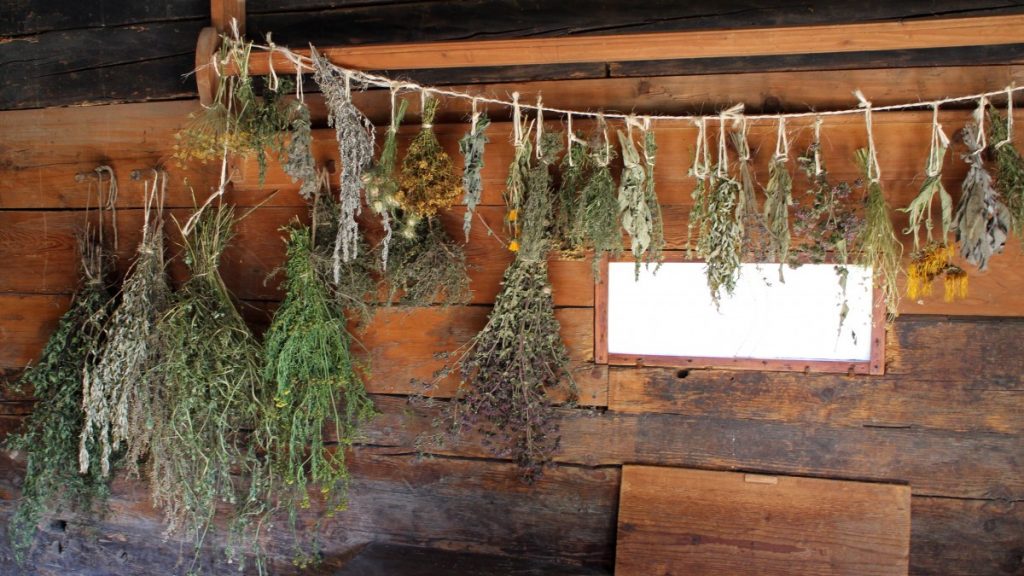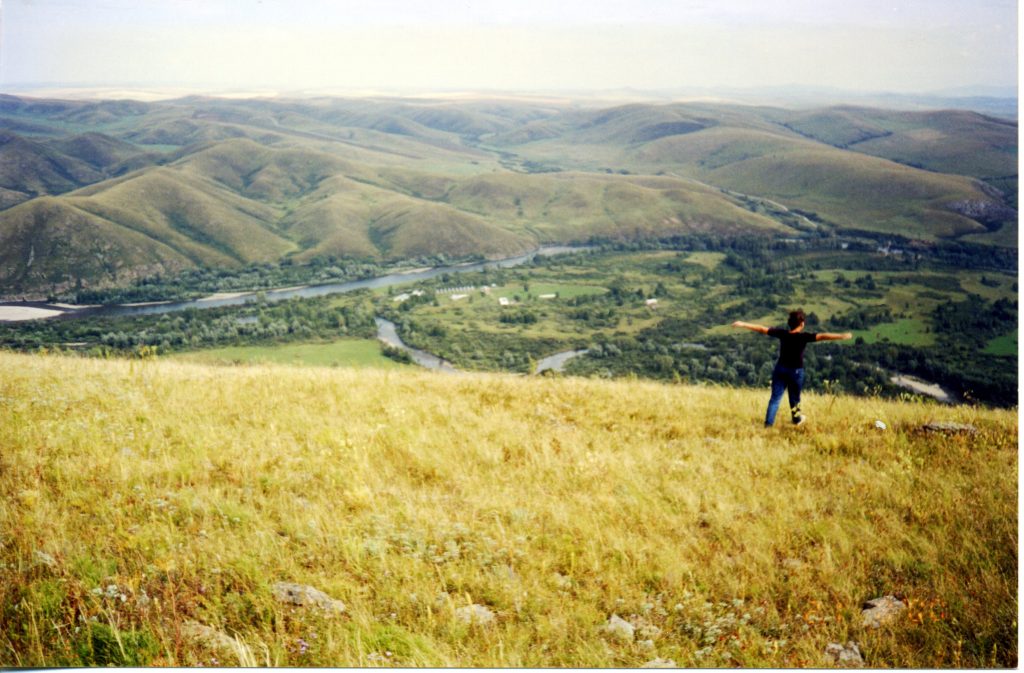It was a hot Siberian summer, about +30C/ 86F. My friend and I visited my grandmother in a rural locality in the Altai region, near the Kazakhstan border. My grandmother and three other grannies, her besties, took us to pick wild strawberries. We marched a few kilometres on foot, away from the village, and reached “the hills”, the hilly place that looked untouched by human civilization. While everyone got busy picking berries (one in the basket, two in the mouth), my grandmother looked for herbs.
The hills were covered with wildflowers and blooming plants, and each of the plants was good for something. Since my grandmother grew up in that area, she knew those herbs and stocked up on them every summer. On that day, she cut a few bushes of hypericum, зверобой, and a few perfect sprigs of oregano, душица. These two herbs are commonly used in herbal teas in winter and are known for their pleasant fragrance and anti-inflammatory effect. When we brought the herbs home, the scent of a summer meadow filled the whole house.
Just a Part of Everyday Life
Herbs are very common in Russia. My mom, a retired pediatrician, always grew herbs in our dacha or hand-picked them in the wild. You might think that my family was obsessed with traditional medicine. No, this wasn’t the case. Back then it was only natural to have herbs in a kitchen cabinet. In my childhood, every family did that. And today, herbs are as popular in Russia as they were back then.
The love for herbs in the Soviet Union wasn’t blind. Herbs were never considered a substitute for prescription drugs. Herbal teas, tinctures, and infusions were supplements. They complemented drugs and helped people to stay healthy. Nobody would treat pneumonia with herbs alone. A patient with pneumonia would receive antibiotics, antipyretics, and on top of that, a licorice root tea or a few other varieties of herbal teas specifically made to promote expectoration and fast recovery. Nobody would ever consider herbs as a substitute for evidence-based medicine.
Another thing that herbs were not is they were not fancy. Using herbs nowadays has become trendy, like drinking craft beer or, before that, eating quinoa. Well, in the Sovet Union, it wasn’t neither fashionable, nor exotic. Even ready-made herbal teas and herb mixes from a drugstore were dirt cheap. When I see double-digit price tags on herbal teas or natural supplements in North American supermarkets or online shops, I can’t believe my eyes. In Russia, herbs still cost pennies.

Herb Supply Chain in the Soviet Union
Even back in my Soviet childhood, people could easily buy herbs in ordinary drugstores. It could be small packs of loose leaves and flowers, it could be herbal teas, or even pills. Drugstores bought raw, freshly picked herbs from everyone who was willing to pick the plants and make a little bit of extra money. Then the herbs would be sorted, dried in proper conditions (cool, dark, drafty rooms are ideal for that), and packed.
Old grannies, like my grandmother, were the usual source of herb supply for drugstores. They had the necessary expertise and would bring high quality material. But summer camps also employed children to pick herbs, because summer camps were usually located in the woods, where the air was clean, and herbs were thriving. My husband told me that when he was in summer camp, he and his comrades were often assigned with the task to pick мать-и-мачеха, coltsfoot, which was abundant in that area.
Times changed, and today, herbal products are produced by private companies, and sold through private drugstores and supermarkets. What didn’t change is that people in Russia still actively use herbs and, when possible, pick them in the wild or plant them on their dachas.
Caution and Common Sense
One can ridicule traditional medicine and think that herbs are useless, but denying the power of herbs would be very unwise. Humankind has been using herbs for killing each other for millennia. Often, the very same plant can be a cure and a fatal poison. It’s all about the dosage. So, if you want to start using herbs in your everyday health care routine, learn about side-effects and contraindications. Ideally, I’d recommend learning how exactly this or that herb works, what chemical elements it contains, and how it affects the human body.
Many herbs may cause allergic reactions, from itching, to laryngospasm and shortness of breath. If you are allergic to something, talk to your doctor before taking herbs known for causing allergies.
If you take meds, think about how herbs would interfere with them. The way our body utilizes meds is often the same way it utilizes herbal extracts, and sometimes, they may not go together well.
Generally, learn as much as possible about what you put into your mouth, and you’ll be safe.
I learned to be careful with herbs the hard way. That day when my grandmother picked my favourite oregano, I decided to put a few plants under my pillow, because they smelled so nicely! Next day, I woke up with a horrible headache. My stomach revolted, and my mind was unclear after a night full of nightmares. It was an herbal OD.
Most Common Russian Herbs
Here is a list of some common herbs that are popular in Russian traditional medicine:
- Аптечная ромашка, chamomile — upset stomach, skin care, irritable bowel syndrome; has anti-inflammatory and bactericidal effect, can be used for treating cramps during periods.
- Валериана, valeriana, — a sedative used for treating insomnia and anxiety; though pretty potent, valeriana should not be used with other depressants or antihistamine drugs.
- Душица, oregano – has expectorant, diuretic and sedative effects; comes in herbal teas for the common cold and flu.
- Зверобой, hypericum — used to treat depression, has a moderate antibacterial effect, eases arthritis pain; has many contraindications, use with caution.
- Календула, pot marigold — has anti-viral, anti-fungal, and anti-inflammatory properties; can be used for treating skin issues and wounds; as a tea, is used for stimulating liver function and improving appetite.
- Крапива, stinging nettles — known as the “ladies herb”, it is used to normalize periods and reduce bleeding; when infused in boiling water, it works as a hair conditioner and makes hair strong and silky.
- Мать-и-мачеха, coltsfoot, — has anti-inflammatory and expectorant effects; is used for the treatment of disorders of the respiratory tract, skin, locomotor system, viral infections, flu, colds, fever, rheumatism and gout.
- Пустырник, motherwort — promotes good sleep, calms down nerves, and is used to treat anxiety.
- Солодка, licorice — used to treat respiratory diseases, fever, stomach ulcers, rheumatism, and skin diseases; has strong expectorant and antibacterial effects; a mild laxative.
- Тимьян, aka чабрец, thyme — has expectorant and antibacterial effects; thyme extract is used as a natural antiseptic in popular mouthwash products.
This list is incomplete, but sufficient to start your own phyto-treasure box. Again, use herbs with caution, and stay healthy!

